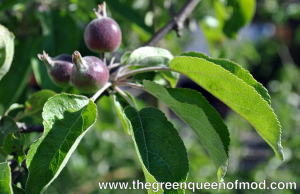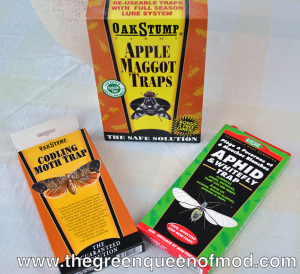Organic Pest Control – Part II

Block or trap those pesky insects.
 My previous post on beneficial insects showed how you can keep your garden relatively free of crawly plant destroyers like aphids and cabbage moth larvae. This post gives you tips to deal with flying insects that like to bore into your apples and other fruits and veggies.
My previous post on beneficial insects showed how you can keep your garden relatively free of crawly plant destroyers like aphids and cabbage moth larvae. This post gives you tips to deal with flying insects that like to bore into your apples and other fruits and veggies.
It wasn’t until we planted our first apple trees that we had to think about apple maggots and coddling moths. We refuse to use chemicals in our garden. Personally, I’d rather have less-than-perfect produce than cause potential harm to birds and bees—and my family.
When the trees were young, we let the insects have their way. The apple maggots don’t cause a lot of damage. The adult drills one hole, lays an egg and goes on its way. The apples still grew and tasted fine; I just needed to be judicious when I cut them—fine for cooking, but not for fruit baskets.
 We decided to try a barrier method that used apple “socks” to keep the maggots from accessing their potential nurseries. The socks are similar to nylon stockings — about four inches long, sewn up at one end. If I wore a lot of pantyhose and knee-highs, which I don’t, I could probably make my own.
We decided to try a barrier method that used apple “socks” to keep the maggots from accessing their potential nurseries. The socks are similar to nylon stockings — about four inches long, sewn up at one end. If I wore a lot of pantyhose and knee-highs, which I don’t, I could probably make my own.
Instead, we ordered a pack of “socks” from Territorial Seed. It’s ideal to put them on at the same time you thin your baby apples (to about six inches apart). I am lucky that my hubby does that job. At 5’1”, I’d need a stepladder at least. Rodale Organic Gardening also recommends that you keep the area below the tree tidy of fallen leaves.
Another method to combat apple maggots is to put out decoy apples (red plastic balls) spread with a sticky substance that both attracts and traps the pests. Unfortunately, the decoy can only be used once as it gets gross by the end of the season and is not easily washed. We’re checking for plastic fruit at thrift stores, but it’s hard to find these days.
 The coddling moths on the other hand tend to spread throughout the apple, leaving the inside brown and mealy. The best organic option to combat them is sticky traps. We got ours in the same order as the apple socks. Neither method is attractive, but the reward is lovely fruit come fall.
The coddling moths on the other hand tend to spread throughout the apple, leaving the inside brown and mealy. The best organic option to combat them is sticky traps. We got ours in the same order as the apple socks. Neither method is attractive, but the reward is lovely fruit come fall.
When ladybugs and other beneficials don’t keep our aphids and other crawlies under control, I use two methods:
1. A blast from a hose (on jet spray) washes the crawlies away enough to keep them in check. This works great on strong plants like lilies and edibles like broccoli.
2. A few squirts of insecticidal soap is better for more delicate plants and edibles that can be thoroughly washed (lettuce as opposed to leeks). I’ve bought some, but make my own as well with this simple recipe. I remember my grandmother using leftover dishwater decades ago.
 Slugs are a big problem here in the Pacific Northwest West; I opt for the beer trap method. I got this lovely ceramic trap at a craft fair, but a saucer works well when rain isn’t an issue. Hubby likes having an excuse to open a beer too! You can easily kill slugs you see by pouring salt on them, but it’s the ones you don’t see that you have to worry about. Eartheasy has a number of options on their site.
Slugs are a big problem here in the Pacific Northwest West; I opt for the beer trap method. I got this lovely ceramic trap at a craft fair, but a saucer works well when rain isn’t an issue. Hubby likes having an excuse to open a beer too! You can easily kill slugs you see by pouring salt on them, but it’s the ones you don’t see that you have to worry about. Eartheasy has a number of options on their site.
 Finally, let’s talk about yellow jackets! They can be beneficial and eat destructive pests, but can be a true nuisance when we’re dining outdoors. My daughter feared them so much that she wanted to eat inside. So, we put up a simple trap to keep them away from our table. We’d pop in some cut-up hotdog when eating, to distract them from our plates—works great and can be taken down easily. You can find them at any garden store.
Finally, let’s talk about yellow jackets! They can be beneficial and eat destructive pests, but can be a true nuisance when we’re dining outdoors. My daughter feared them so much that she wanted to eat inside. So, we put up a simple trap to keep them away from our table. We’d pop in some cut-up hotdog when eating, to distract them from our plates—works great and can be taken down easily. You can find them at any garden store.
I’d love to hear about organic pest control methods you might use—please comment below. Happy gardening!
- Words by Andrea Leigh Ptak
- June 10, 2014
- 1 Comment
Never knew about the cut up hot dog. Kyle hates yellow jackets and wasps. Thanks for the tip.